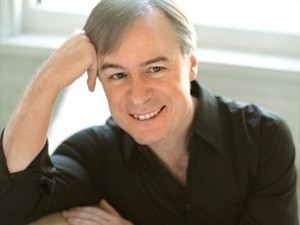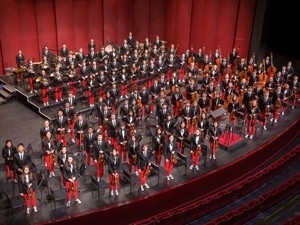|
Back
Maestro Robertson Dons His Dancing Shoes New York
Isaac Stern Auditorium, Carnege Hall
07/22/2014 - & July 20 (Purchase), 24 (Tanglewood), 26 (Boone), 28 (Chicago), 30 (Teton Village), August 2 (Rohnert Park), 4 (Los Angeles), 2014
Leonard Bernstein: Symphonic Dances, from West Side Story (Re-orchestrated by Sid Ramin and Irwin Kostal)
Benjamin Britten: Violin Concerto, Opus 15 (1965 version)
Samuel Adams: Radial Play
Modeste Mussorgsky: Pictures at an Exhibition (Orchestrated by Maurice Ravel)
Gil Shaham (Violinist)
National Youth Orchestra of the United States of America, David Robertson (Conductor)

D. Robertson (© Michael Tammaro)
Between the Bolshoi Ballet last week and the Mark Morris Dancers next week, the wonderful David Robertson had no choice but to don his loafers (I think they were loafers from the back of Carnegie Hall) and, per usual, dance his way through a rather remarkable program.
To say that Mr. Robertson is one of the most graceful and amiable conductors is stating the obvious. But this was especially remarkable, since he was conducting an ensemble of 120 musicians between the ages of 16-19, and he made them sometimes sound like the New York Philharmonic.
This was the second year of the (take a deep breath for this cumbersome name) National Youth Orchestra of the United States of America. Henceforth known here as NYOUS. Last year, after arduous auditions, the players came together under the stern baton of Valery Gergiev. This year, after equally difficult auditions, the group from around 30 different states, rehearsed at Purchase, New York State University, with First Chair players from other orchestras, made their Carnegie Hall debut last night under the affable Mr. Robertson, and took on Gil Shaham, an equally delightful personality, as violin soloist.
Last night was the premiere. But they will be continuing in a sold-out performance at Tanglewood tomorrow, and a quintet of more concerts from North Carolina and Chicago to Wyoming and California.
So the question comes: are they worth the effort?

The National Youth Orchestra (© NYOUS)
For the choice of program alone, yes. With the two encores (a truncated Porgy and Bess suite, a newly orchestrated America the Beautiful), four of the six works were from this country. All the music was 20th or 21st Century, the newest piece by Samuel Adams (commissioned by Carnegie Hall) was a five-minute dazzlement, and that old warhorse, Mussorgsky’s Pictures was as picturesque as anything I can remember.
They began with a work new to me, the West Side Story “Symphonic Dances.” New because this was certainly not the old pit-orchestra Bernstein piece. Two other orchestrators had set their imagination on fire, giving more color (including a beautiful flute solo by Alejandro Lombo), even more percussion than the original and the kind of counterpoint which one rarely can make out in the vocal version.
In fact, while the NYOUS was a bit blurry, a wee bit off kilter in this first work of the evening, it gave one a chance to hear Leonard Bernstein with his most inventive music, devoid of from the Broadway drama.
One could conceivably say that the Benjamin Britten Violin Concerto was American as well, written during the composer’s American period. No, hardly as Yankee-ish as his opera Paul Bunyan, but with a zest, a fire, and an orchestral flamboyance.
Where Maestro Robertson uses his grace and agility on the dais, Gil Shaham, who has recently championed violin concerts of the 1930’s, walks his way around the platform. Never still for a moment, peering over the orchestra scores, taking his time between those rare moments when he isn’t performing.
This was a typical Shaham show, giving emotional gravity to that most beautiful agitato ma expressivo second theme. Mr. Robertson allowed the fine horn section of making the NYOUS stand out in a kind of chorale. The extremely difficult passages seemed easy. (Apparently the composer’s revisions were to make the solo part more challenging, since the first soloist in 1939 didn’t come up to par.)
The work is rarely played these days, but Mr. Shaham enjoys bringing these post-Romantic works come to the stage. His passion and his technique went together, and his “walkabouts” were more endearing than diverting.
A revelation last night was that America has a new Adams family. Not John and John Quincy and Abagail and Samuel Adams of Revolutionary War fame. But John and Samuel Adams of West Coast musical fame.
John Adams we know. Samuel, his son, is a jazz/acoustic/electronic composer–the usual numbingly eclectic composer of the California scene. His Radial Play, which he dedicated to the NYOUS, is a concise sensation. It starts with an almost childish harp theme (not quite as consonant as it originally sounds), and then dives–I mean plunges–into an orchestral exegesis which bursts that melody open. The theme crashes against other variations, notes become swallowed up, meters change.
Maestro Robertson and his youthful ensemble hit the buttons right. The work is so orchestrally “right” that they only needed to play the notes, and Mr. Adams’ entertaining piece of quantum movements sang for itself.
Five minutes which I would love to hear again and again, for a lot was going on here, more in these five minutes than many another composer who feels a responsibility to fill up more time with more useless filling.
Some in the audience left before Pictures at an Exhibition, and frankly I couldn’t blame them, for this is played all too frequently. Truth be told, though, this was NYOUS at its very very best. The Ravel calls for lots of solos, and these teenagers loved the chance, starting with a blazing trumpet solo by Matthew Gajda, going back with that wonderful brass team, and, I must admit it, the sexiest alto sax solo I’ve ever heard in this work, played by one Chad Lilley.
The notes weren’t all Ravel’s (he added a tiny jazzy grace note to the final phrase), but he, Maestro Robertson and the Orchestra gave it a transparent, volatile and committed performance which made Carnegie Hall’s rafters ring.
Harry Rolnick
|